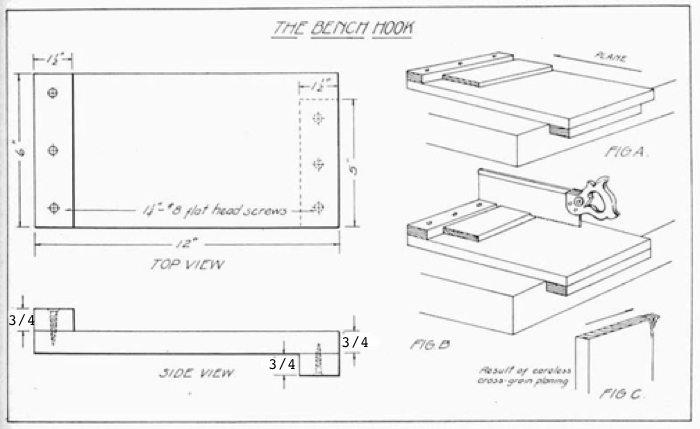
"Helping Woodworkers online for over 20 years"
Bench Hook
|
The bench hook is a very useful article to have about the work
bench. It is made of hard wood, preferably maple. The drawing is shown
below. The main piece is made 3/4" × 6" × 12". Two cross cleats are
made, one being 3/4" × 1-1/2" × 6" and the other 3/4" × 1-1/2" × 5".
Holes are bored and countersunk at the places shown in the drawing.
Great care must be taken in cutting these three pieces of wood to see
that every edge is square and true. One of the cleats is attached on one
side of the board even with the end, while the other is placed on the
other side on the opposite end. These are held in place with glue and
1-1/4" No. 8 flat-head screws. By referring to the drawing the idea may
be readily seen. It will be noticed that the short cleat has its end
even with the left-hand edge, thus leaving a space of an inch at the
right. When used with this side up it is for the purpose of sawing off
small pieces of wood with the back saw, and when used with the other
side up, on which the long cleat is attached, it is for the purpose of
planing the end of a piece of wood across the grain. Assembly Instructions
It can be readily seen that supported as it now is, the piece
of wood being planed will not splinter or break on its further edge.
Pains must be taken, however, to keep the plane flat on its side, not
raising it on its edge at all, for by so doing the resulting planed edge
will not be square. This bench-hook may be made quite easily by the
beginner and besides being a good problem, is a very helpful addition to
the tool outfit. It works very well when planing wood not over six or
seven inches wide. Wood wider than this should be planed as follows:
Place the piece of wood upright in the vise with the end grain
uppermost, and plane about three-quarters of the way across the edge.
Then turn the piece and plane the remaining part back in the opposite
direction. By so doing the end of the wood will not be split. |
